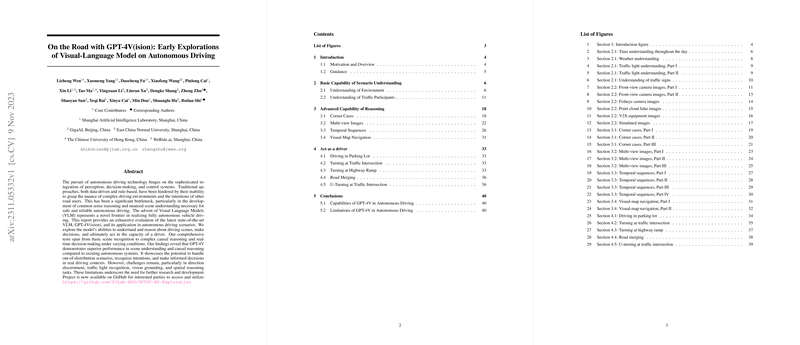An Expert Evaluation of GPT-4V's Potential in Autonomous Driving
The integration of perception, decision-making, and control systems is paramount in the development of autonomous driving technologies. The traditional methodologies, utilizing data-driven or rule-based approaches, possess inherent limitations in understanding complex driving environments and the intentions of other road participants. These limitations, particularly evident in common-sense reasoning and nuanced scene comprehension, present significant challenges in achieving safe and reliable autonomous driving.
To address these challenges, this paper investigates the introduction of Visual-LLMs (VLMs), specifically GPT-4V(ision), within the domain of autonomous driving. GPT-4V represents a promising advancement, with capabilities to analyze visual data alongside textual instructions, potentially bridging the existing gap in autonomous driving systems.
Key Evaluations and Findings
The research rigorously evaluates GPT-4V's potential in various autonomous driving scenarios with a focus on three core capabilities: scenario understanding, reasoning, and acting as a driver.
- Scenario Understanding:
- The model demonstrated commendable proficiency in comprehending traffic scenes, identifying objects, and recognizing their states and intents. The ability to identify weather conditions and interpret pedestrian and driver intentions highlights a level of common-sense reasoning that traditional models lack.
- Reasoning Ability:
- The paper spotlights GPT-4V's ability to navigate complex corner cases, utilizing common-sense reasoning to assess out-of-distribution scenarios and dynamic traffic environments successfully.
- Multi-view comprehension tasks highlighted the model's ability to integrate sensory information from various camera inputs, improving spatial understanding.
- Temporal sequence analysis indicates GPT-4V's potential in understanding continuous frames, though spatial reasoning within these frames remains challenging.
- Driving Performance:
- The most intriguing insight stems from the model's potential to act as a driver in real-world scenarios. The experiments conducted emphasize GPT-4V's driving decision-making capabilities, wherein it navigates various real-world situations such as parking lots and busy intersections. Despite its strengths, limitations in spatial reasoning and difficulty in handling traffic lights in nighttime scenarios illustrate areas for further development.
Limitations and Challenges
While GPT-4V exhibits promising capabilities, this paper points out several existing limitations that must be addressed:
- Direction and Traffic Light Recognition: The model often struggles with accurate recognition of directional cues and traffic light states, which are critical for autonomous driving safety.
- Vision Grounding and Spatial Reasoning: The absence of precise localization and bounding box abilities hinders the model's effectiveness in real-world perception.
- Cultural and Language Considerations: The handling of non-English traffic signs also presents a hurdle.
Implications and Future Prospects
The paper elucidates the potential and limitations of integrating VLMs like GPT-4V into autonomous systems. The findings underscore the necessity for further advancements in spatial reasoning and cross-domain language proficiency. Additionally, the integration of VLMs with conventional perception techniques could offer substantial benefits, combining knowledge-based reasoning with existing sensory algorithms.
The trajectory of GPT-4V’s application in autonomous driving reflects broader trends within AI research, indicating a potent shift towards models capable of dynamic reasoning and broader contextual understanding. Yet, the emphasis on addressing safety concerns and augmenting existing capabilities remains paramount.
In summary, the examination of GPT-4V's application in autonomous driving offers a compelling glimpse into the model's current state and potential future directions. The ongoing development of such models addresses fundamental challenges within autonomous driving, making strides towards more nuanced, safe, and reliable autonomous systems.
